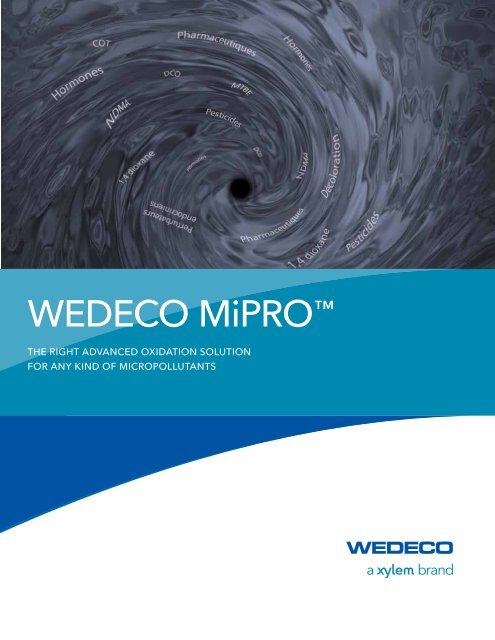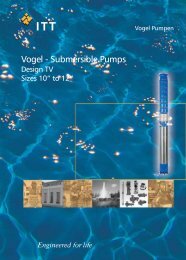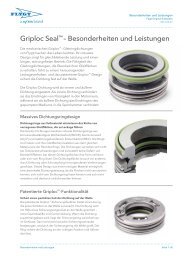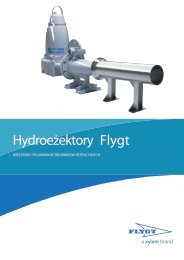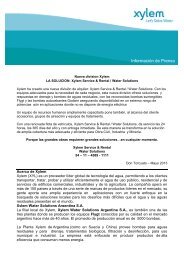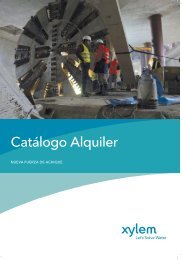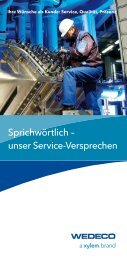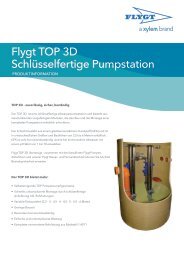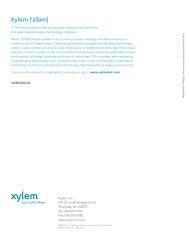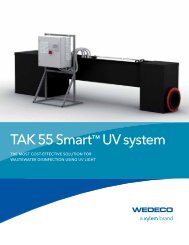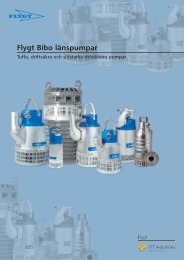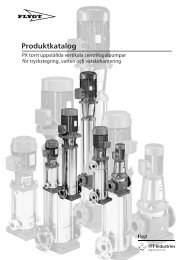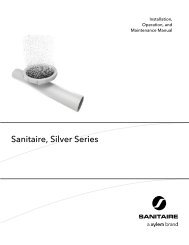WEDECO MiPRO™ Oxidation Solution Brochure
WEDECO MiPRO™ Oxidation Solution Brochure
WEDECO MiPRO™ Oxidation Solution Brochure
You also want an ePaper? Increase the reach of your titles
YUMPU automatically turns print PDFs into web optimized ePapers that Google loves.
<strong>WEDECO</strong> MiPRO <br />
The right Advanced <strong>Oxidation</strong> <strong>Solution</strong><br />
for any kind of Micropollutants
Why Advanced <strong>Oxidation</strong> Process<br />
Water utilities are reporting a worldwide rising<br />
trend as far as problematic micropollutions in<br />
water resources are concerned. Traces of organic<br />
/ anorganic pollutants like NDMA, MTBE, 1.4<br />
Dioxan, EDC, etc. are often found in ground and<br />
surface water.<br />
The reasons for the increasing degree of contaminations<br />
are to be found in the process of industrialization,<br />
intensive agriculture as well as all-round medical provision<br />
for humans. Once these micropollutants enter the<br />
human food chain via drinking water, there is a long<br />
term risk to health or even to human or animal genetic<br />
material. Traditional treatment methods are no longer<br />
sufficient to guarantee complete removal of these<br />
contaminants.<br />
Due to climate and demographic changes, many water<br />
utilities are expecting further pollutions of the drinking<br />
water resources in the near future. As a consequence,<br />
there is a higher risk of water scarcity and thus there<br />
will be an increasing demand for direct or indirect reuse<br />
of wastewater for drinking water purposes.<br />
NDMA (N-Nitrosodimethylamine)<br />
»»<br />
Is highly toxic and a suspected human<br />
carcinogen<br />
»»<br />
Is a Industrial by-product / waste product of<br />
several industrial processes<br />
»»<br />
Is harmful in drinking water at minute<br />
concentrations<br />
»»<br />
Is difficult to remove from drinking water. It<br />
does not readily biodegrade, adsorb, or volatilize.<br />
As such, it cannot be removed by activated<br />
carbon and travels easily through soils.<br />
1.4 Dioxane<br />
»»<br />
Causes eye and respiratory tract irritations and<br />
is suspected of causing damage to the central<br />
nervous system, liver and kidney<br />
»»<br />
Used in solvent applications for the manufacturing<br />
sector, in fumigants or automotive coolant.<br />
Partly contained in cosmetics products,<br />
such as deodorants, shampoos, toothpastes<br />
and mouthwashes.<br />
»»<br />
Forms contamination plumes in groundwater<br />
when released to the environment<br />
»»<br />
Difficulty removal since it does not readily bind<br />
to soils and is resistant to naturally occurring<br />
biodegradation processes.<br />
Pesticides<br />
»»<br />
are one of the causes of water pollution since<br />
only a minor portion of the applied amount is<br />
incorporated by the target species.<br />
»»<br />
are partly persistent organic pollutants and<br />
contribute to soil contamination<br />
»»<br />
causes particularly pollutants of surface water,<br />
i.e. due to runoff from agricultural areas draining<br />
into a river (Nonpoint Source Pollution)<br />
Residuals of Pharmaceuticals<br />
»»<br />
ends up in the environment via sewage from<br />
bodily excretion or improper disposal of<br />
unused pharmaceuticals. Main influx paths in<br />
surface waters are municipal wastewater treatment<br />
plants, drainage from the pharmaceutical<br />
industry animal breeding grounds or medical<br />
centres<br />
»»<br />
Are partly persistent. As a result, the number<br />
of contaminants in our water circulation<br />
and its consumers is creeping upwards<br />
(bioaccumulation)<br />
»»<br />
may cause endocrine effects on humans and<br />
animals<br />
2
Run your most efficient path of AOP<br />
The Advanced <strong>Oxidation</strong> Process (AOP) is the ideal<br />
approach on this new kind of water contaminations.<br />
AOP is the combination of two or more processes to<br />
generate hydroxyl radicals (OH radicals) or to increase<br />
the number of them. The OH radicals contribute to<br />
the oxidation of undesirable substances. Compared to<br />
other oxidants, the OH radical has a considerably higher<br />
oxidation potential.<br />
Once hydroxyl radicals have formed in water, they<br />
immediately react to virtually all existing oxidizable<br />
substances. The high degradation performance and the<br />
quick reaction kinetics of this process are the formula<br />
for success when it comes to eliminate numerous persistent<br />
contaminations.<br />
In theory, there are 20 different methods to technically<br />
create hydroxyl radicals. In practice, two basic processes<br />
have become established:<br />
Ozone + Hydrogen Peroxide<br />
OH Radical<br />
Ozone*<br />
Hydrogen Peroxide*<br />
Permanganate*<br />
Hypochlorite*<br />
Chlorine<br />
Chlorine Dioxide*<br />
Oxygen molecule*<br />
* measured at a pH-value = 0<br />
0.0 0.5 1.0 1.5 2.0 2.5 3.0<br />
<strong>Oxidation</strong> potential [V]<br />
Compared to other oxidants, OH radicals have<br />
a considerably higher oxidation potential<br />
In the presence of hydrogen peroxide (H 2<br />
O 2<br />
), ozone (O 3<br />
)<br />
reacts with the anion of the hydrogen peroxide (HO 2<br />
-),<br />
and creates hydroxyl radicals in this way. This reaction is<br />
quicker and more effective than the reaction of ozone<br />
with water by itself.<br />
UV Light + Hydrogen Peroxide<br />
In this process, the electromagnetic irradiation (UV<br />
light) is absorbed by the hydrogen peroxide dissolved in<br />
the water. In theory, this process leads to the formation<br />
of two OH radicals, made from one H 2<br />
O 2<br />
molecule.<br />
3
Engineered solutions for various applications<br />
ITT’s <strong>WEDECO</strong> MiPRO concept is based on three key<br />
components: Ozone, Hydrogen Peroxide and UV light.<br />
By combining these technologies, flexible solutions for<br />
individual requirements are given. The choice of the<br />
qualified technologies always depends on the actual<br />
problematic substance, considering on-site conditions<br />
like footprint, flow rate and energy costs. Our philosophy<br />
is to design each <strong>WEDECO</strong> MiPRO solution as the<br />
perfect complement to the existing process. The overall<br />
aim: Ensured removal performance with the highest<br />
efficiency possible.<br />
Ozone<br />
Ozone, by itself, is a multifunctional powerful oxidant and has numerous<br />
positive treatment effects, e.g. disinfection, color reduction, COD reduction.<br />
<strong>WEDECO</strong> Ozone systems produce ozone on-site from liquid oxygen or air.<br />
The gas can be incorporated into the water either by use of reaction bassins/<br />
tanks or Pump-Injection systems.<br />
H 2<br />
O 2<br />
Hydrogen Peroxide is a pale blue (or colorless when diluted) substantial<br />
liquid of Hydrogen (H) and Oxygen (O). It reacts oxidatively and is used<br />
as an agent for bleaching and disinfection. Hydrogen Peroxide is stored onsite<br />
and is dosed into the water in liquid state.<br />
UV light<br />
Ultraviolet light is energy-rich light with a wavelength of 200 – 400<br />
nanometers (nm). UV light is very versatile and can be used for disinfecting<br />
water and oxidation processes. The light is generated in special UV lamps<br />
protected by water-tight quartz sleeves. The water (pure or supplemented<br />
with Ozone and/or Hydrogen Peroxide) flows over the quartz sleeves, being<br />
irradiated by the UV light.<br />
4
MiPRO eco 3<br />
MiPRO photo<br />
MiPRO eco 3<br />
plus<br />
MiPRO eco 3<br />
MiPRO eco 3<br />
plus<br />
Components:<br />
»»<br />
<strong>WEDECO</strong> Ozone system<br />
»»<br />
H 2<br />
O 2<br />
dosing unit<br />
»»<br />
Injection / reaction unit<br />
»»<br />
Residual Ozone<br />
Destruction system<br />
Application<br />
»»<br />
Most appropriate when<br />
pollutants are degraded<br />
effectively by the radical<br />
reaction path<br />
Advantages:<br />
»»<br />
Favorable operating costs<br />
»»<br />
Suitable for a wide range<br />
of substances<br />
MiPRO photo<br />
Components:<br />
»»<br />
<strong>WEDECO</strong> UV system<br />
»»<br />
H 2<br />
O 2<br />
dosing unit<br />
Application<br />
»»<br />
Especially photosensitive<br />
substances are reduced effectively,<br />
i.e. NDMA<br />
Advantages:<br />
»»<br />
Additional disinfection of<br />
the water by UV light<br />
Components:<br />
»»<br />
<strong>WEDECO</strong> Ozone system<br />
»»<br />
H 2<br />
O 2<br />
dosing unit<br />
»»<br />
Injection / reaction unit<br />
»»<br />
Residual ozone<br />
destruction system<br />
»»<br />
<strong>WEDECO</strong> UV system<br />
Application<br />
»»<br />
All kinds of organic /<br />
anorganic micropollutants<br />
and other persistent<br />
substances<br />
Advantages:<br />
»»<br />
Besides micropollutants,<br />
photosensitive substances<br />
can also be reduced<br />
effectively<br />
»»<br />
Additional disinfection by<br />
UV light<br />
5
Your choice: the Best Available Technology<br />
Ideally, contaminated water should always be treated<br />
using the most efficient of the various processes. This<br />
is why the implementation of an Advanced <strong>Oxidation</strong><br />
Process in water or waste water works should always<br />
begin with the correct selection of the process to be<br />
used.<br />
ITT can help you to find the right solution before you<br />
make any kind of long-term commitment. You benefit<br />
from our many years of experience in AOP and its core<br />
components. <strong>WEDECO</strong> UV and ozone technologies provide<br />
fully developed treatment systems that have been<br />
setting standards in modern water treatment for more<br />
than three decades.<br />
Application Contaminants Ozone UV MiPRO eco 3<br />
MiPRO photo MiPRO eco 3<br />
plus<br />
Industiral Chemicals<br />
Pesticides<br />
Pharmaceuticals<br />
1,4-Dioxane 0 0 ++ + ++<br />
MTBE 0 0 ++ 0 ++<br />
NDMA 0 + + ++ ++<br />
Atrazine + 0 ++ + ++<br />
Bromacile ++ 0 ++ + ++<br />
Diclofenac ++ + ++ ++ ++<br />
Carbamazepine ++ 0 ++ + ++<br />
Ibuprofene + 0 ++ + ++<br />
Amidotrizoic Acid + + + ++ ++<br />
Iohexol + + ++ ++ ++<br />
Hormones ++ 0 ++ + ++<br />
Taste & Odor<br />
Geosmin ++ 0 ++ + ++<br />
MIB ++ 0 ++ + ++<br />
Decolorisation ++ 0 ++ 0 ++<br />
TOC-Removal 0 0 + 0 +<br />
Disinfection + ++ + ++ ++<br />
++ = Removal of 81 - 100% + = Removal of 51 - 80 % 0 = Removal smaller 50%<br />
The implementation of an Advanced <strong>Oxidation</strong> Process should always<br />
begin with the correct selection of the process to be used.<br />
Frequently Asked Questions<br />
“Isn’t really medium pressure UV and Hydrogen Peroxide<br />
the best AOP process”<br />
The combination of medium pressure UV and Hydrogen Peroxide<br />
is well known as AOP process, but it is not the only one.<br />
Combinations of low pressure UV, Hydrogen Peroxide and/or<br />
Ozone do in many cases offer advantages regarding operating<br />
costs, power consumption, removal efficiency or footprint. ITT<br />
under its <strong>WEDECO</strong> brand is able to offer competency based<br />
on both core technologies - UV and Ozone.<br />
“Can Bromate be formed in the case of ozone<br />
application with AOP“<br />
Generally, the formation of Bromate is only possible if relevant<br />
quantities of Bromide are present in the water. If Bromide is<br />
present, the innovative combination of Ozone with Hydrogen<br />
Peroxide allows a significant reduction of the direct reaction of<br />
Ozone with Bromide.<br />
6
€ / m³<br />
0,08<br />
Comparison of costs & consumption per m³<br />
0,07<br />
0,06<br />
0,05<br />
0,04<br />
0,03<br />
0,02<br />
0,01<br />
MiPRO eco 3<br />
Ozone: 5 g<br />
H 2<br />
O 2<br />
: 10 g<br />
MiPRO photo<br />
MiPRO eco 3<br />
plus<br />
EEO: 0,26 kW<br />
H 2<br />
O 2<br />
: 10 g<br />
EEO: 0,16 kW<br />
Ozone: 3 g<br />
H 2<br />
O 2<br />
: 5 g<br />
UV (MP) + H 2<br />
O 2<br />
EEO: 0,56 kW<br />
H 2<br />
O 2<br />
: 10 g<br />
The diagram compares costs and consumption<br />
(energy, ozone, H 2<br />
O 2<br />
) per m³.<br />
The treatment goal of this case is the<br />
reduction of pesticides and pharmaceuticals<br />
at a water flow of 2.000 m³/h. The<br />
costs includes capital costs, footprint,<br />
oxygen, energy, H 2<br />
O 2<br />
and maintenance.<br />
In addition to our established expertise, we possess<br />
our own lab and research facilities for water treatment,<br />
which investigate the specific research requirements of<br />
our customers.<br />
Our experts determine the right procedure for your situation<br />
on site at your facility using mobile AOP validation<br />
stations. This does not only apply to new treatment<br />
systems - it can also be used to optimize existing<br />
processes. The various procedures can be tested based<br />
on your specific parameters in just a short period of<br />
time. Practical experience, after all, provides results that<br />
are more tangible and more promising than theoretical<br />
approaches.<br />
“How can a combination of O 3<br />
, H 2<br />
O 2<br />
and UV be less<br />
expensive than H 2<br />
O 2<br />
/ UV”<br />
Different water contaminants are treated best with the most<br />
suitable technology, tailored for the specific contaminant removal.<br />
The MiPRO eco 3<br />
plus solution allows to design each<br />
single step to the optimum. This optimisation results in lower<br />
total treatment cost.<br />
“Why does low pressure UV irradiation work<br />
especially well with AOP”<br />
In many cases, photosensitive substances like NDMA or Amidotrizoic<br />
Acid are directly degraded very efficiently with UV<br />
light (254 nm). By photolysis, the UV light causes the breaking<br />
up of the chemical compounds and thus the degradation of<br />
the pollutants. In addition, the activation of Hydrogen Peroxide<br />
leads to effective oxidation of micro-pollutants.<br />
7
Xylem |'zīl m|<br />
e<br />
1) The tissue in plants that brings water upward from the roots;<br />
2) a leading global water technology company.<br />
We’re 12,000 people unified in a common purpose: creating innovative solutions to<br />
meet our world’s water needs. Developing new technologies that will improve the way<br />
water is used, conserved, and re-used in the future is central to our work. We move, treat,<br />
analyze, and return water to the environment, and we help people use water efficiently, in<br />
their homes, buildings, factories and farms. In more than 150 countries, we have strong,<br />
long-standing relationships with customers who know us for our powerful combination<br />
of leading product brands and applications expertise, backed by a legacy of innovation.<br />
For more information on how Xylem can help you, go to www.xyleminc.com<br />
WB009-896854 • <strong>WEDECO</strong> MiPRO <strong>Oxidation</strong> <strong>Solution</strong> <strong>Brochure</strong> • 04/2012 • US<br />
Xylem, Inc.<br />
14125 South Bridge Circle<br />
Charlotte, NC 28273<br />
Tel 704.409.9700<br />
Fax 704.295.9080<br />
www.xyleminc.com<br />
<strong>WEDECO</strong> is a trademark of Xylem Inc. or one of its subsidiaries.<br />
© 2012 Xylem, Inc. JAN 2012


